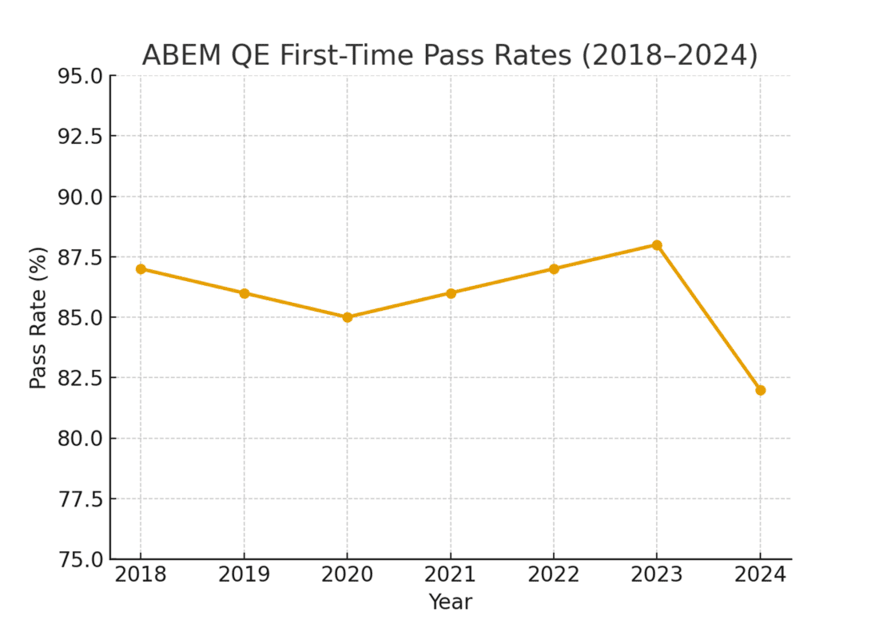ABEM Board Exam Guide 2025: How to Prepare and Pass
Last updated: October 2025
ABEM Board Exam Guide 2025 - Prep, Format, and Pass Strategies
The American Board of Emergency Medicine (ABEM) board exam is a pivotal step for emergency medicine physicians. This guide outlines how the certification process works now — and what will change soon.
👉 Start preparing now with Med-Challenger’s ABEM Emergency Medicine Review Course
What is the ABEM board exam?
The ABEM board exam process consists of a Qualifying (written) Exam and a Certifying Exam. The Qualifying (written) portion remains unchanged; the Certifying Exam is being introduced in 2026, replacing the current virtual Oral format.

Who is eligible to take which ABEM exam and when?
You must complete an ACGME-accredited EM residency, be recommended by your program director, and apply during ABEM’s published windows.

What is the ABEM eligibility window and what happens if you delay?
Physicians generally must complete certification within a limited time (e.g., 5 years) after residency. If this eligibility window lapses, you may need additional credentials or retraining. (Note: check ABEM’s current eligibility policy for final wording.)
How do you register for the ABEM exam and what are the fees?
You apply via ABEM and register through Pearson VUE during specified windows. The typical exam fee is in the range of $1,000 to $1,500 (pending ABEM’s release). Late registration or reschedules carry surcharges.
What is the structure of the ABEM exam?
The Qualifying (written) Exam includes ~305 multiple-choice, single-best-answer questions. It is split into two sessions of 3 hours, 10 minutes each, separated by a one-hour break, for around 8 hours of total appointment time (6 h 20 min of testing).
👉 The ABEM Board Exam: A Comprehensive Guide
Questions include both non-pictorial (text) and pictorial (ECGs, X-rays, ultrasounds, CTs, dermatology images). Reference documents (abbreviation list, normal lab values) are available during the exam.
👉 How to Interpret Images on the ABEM Exam
When is the ABEM exam in 2025?
- Qualifying (Written) Exam: November 3–12, 2025

- Oral / Certifying Windows

What topics are covered on the ABEM exam (ABEM Blueprint)?
ABEM uses the 2022 EM Model for exam content development. The 2022 model became effective starting with the 2024 Qualifying Exam and 2025 In-Training Exam.
Weights by content area (as per the blueprint) include:

The 2022 update expanded the ultrasound component of Procedures and refined Category 20 (“Other Core Competencies”) especially around patient-centered care.
Which procedures and skills are high-yield on the ABEM exam?
Airway management, central venous access, chest tube insertion, procedural sedation, ultrasound (FAST, point-of-care), wound closure/abscess drainage are commonly tested procedural skills.
How is the ABEM exam scored and when are results released?
The Qualifying Exam is criterion-referenced, scored on a 0–100 scale, with 77 required to pass. Results are typically released within 90 days to candidates via the ABEM portal.
What are ABEM exam pass rates and do ITE scores predict success?
In 2023, the first-time pass rate for residency-trained candidates was ~88%. Past experience suggests low ITE scores are a red flag for risk, but high ITE scores don’t guarantee a passing result on the boards.
👉 What Are the ABEM Pass Rates — and How Hard Is the Exam?
What are the best study strategies for the ABEM exam?
The most effective preparation aligns with the EM Model: use a QBank mapped to the blueprint (such as Med-Challenger EM Review), practice timed mock exams, emphasize high-yield topics (cardiac, respiratory, trauma), and build strong image-interpretation skills.
Mix “assessment” (knowledge-check) and “teaching” (case-based) questions. Also, break study into frequent shorter sessions rather than long marathon blocks.
How should you approach ABEM question styles?
- Assessment questions: Straightforward single-best-answer type with carefully designed distractors.
- Teaching / case questions: More complex, designed to teach or probe deeper reasoning.
- Tactics: Read the stem carefully, flag modifiers (e.g. “EXCEPT,” “MOST LIKELY”), eliminate obviously wrong answer choices, and time yourself.
👉 How I Prepared for and Passed the ABEM Exam
What is the ABEM oral (certifying) exam — and what’s changing?
Current Oral (Virtual) Format (through 2025):
- The Oral Exam is currently delivered virtually and involves structured patient cases and interactive questioning.
Changes coming in 2026 — new Certifying Exam:
- The virtual Oral Exam will retire after 2025.
- The new Certifying Exam begins in 2026.
- It will be in-person at the AIME Center in Raleigh, NC.
- Two case types will be used: Clinical Care Cases and Communication & Procedure (OSCE-style) Cases.
- Clinical cases: approximately 15 minutes each; assess clinical decision-making, prioritization, adaptability, etc.
- OSCE cases: 10–15 min each; use standardized patients or procedural setups to assess communication, procedural skill, conflict management, etc.
- There will be ~9 exam administrations per year to improve scheduling flexibility.
- ABEM is developing rubrics, standard-setting processes, and scoring equating to ensure fairness.
Transition rules:
- Physicians who pass the Oral Exam in 2024 or 2025 will not have to take the new Certifying Exam.
- The Qualifying (written) exam will not change under this new model.
👉 ABEM Board Exam Update 2026: From Oral Exam to OSCE-Based Certifying Exam
What are common pitfalls and myths about the ABEM exam?
- Overemphasis on rare diseases while neglecting high-yield common emergency conditions.
- Not practicing enough image- or signal-based questions (ECGs, CTs, ultrasounds).
- Assuming strong ITE performance guarantees board success.
- Neglecting the pediatric or geriatric components (which have minimum weightings).

What should I expect on ABEM exam day?
Expect an 8-hour appointment (including breaks), check-in and identification steps, strict time constraints, and a scheduled break. Pace yourself, take care of logistics (snacks, rest breaks), and if time permits, revisit flagged questions.
What happens after the ABEM exam?
- Qualifying exam results arrive within ~90 days.
- If unsuccessful, you can reapply in the next exam cycle (with associated fees).
- Use exam score feedback to focus remedial study on weaker domains.
What is ABEM continuing certification (MOC)?
After certification, physicians must maintain it via methods such as MyEMCert modules, CME, Improvement in Medical Practice (IMP) projects, professionalism, and ongoing assessments.
FAQs about the ABEM exam
How long is the ABEM exam?
Roughly 8 hours including breaks.
How hard is the ABEM exam?
Challenging: in 2023, ~88% of first-time residency-trained candidates passed.
What is the passing score for the ABEM exam?
77 out of 100 (scaled).
Which ABEM question bank is best?
Top choices are those aligned with the 2022 EM Model and the ABEM blueprint; Med-Challenger is often recommended.
👉 What is the Best Emergency Medicine Question Bank?
What happens if I fail the ABEM exam?
You can retake during the next available exam window, but must reapply and pay applicable fees.
When does the new Certifying Exam begin?
The new Certifying Exam replaces the virtual Oral format starting in 2026.
Next steps for ABEM prep
✅ Enroll in an ABEM-aligned review course (e.g. Med-Challenger)
✅ Track ABEM’s official updates on the Certifying Exam and blueprint changes
✅ Follow practice exams, especially focused on new case-style reasoning and OSCE simulations
How can you prepare for the ABEM Exams? Med-Challenger Emergency Medicine Boards Prep



.png)

